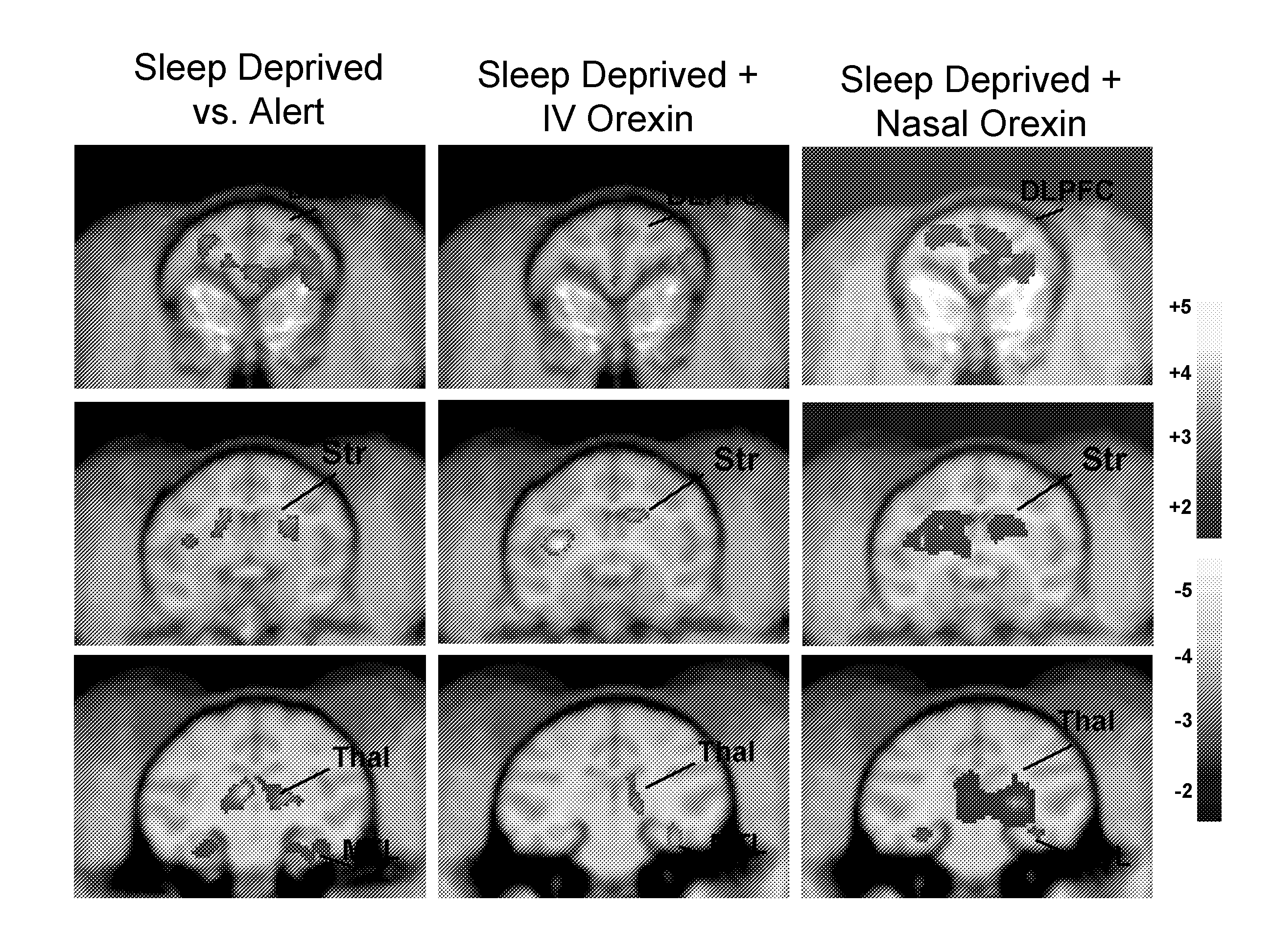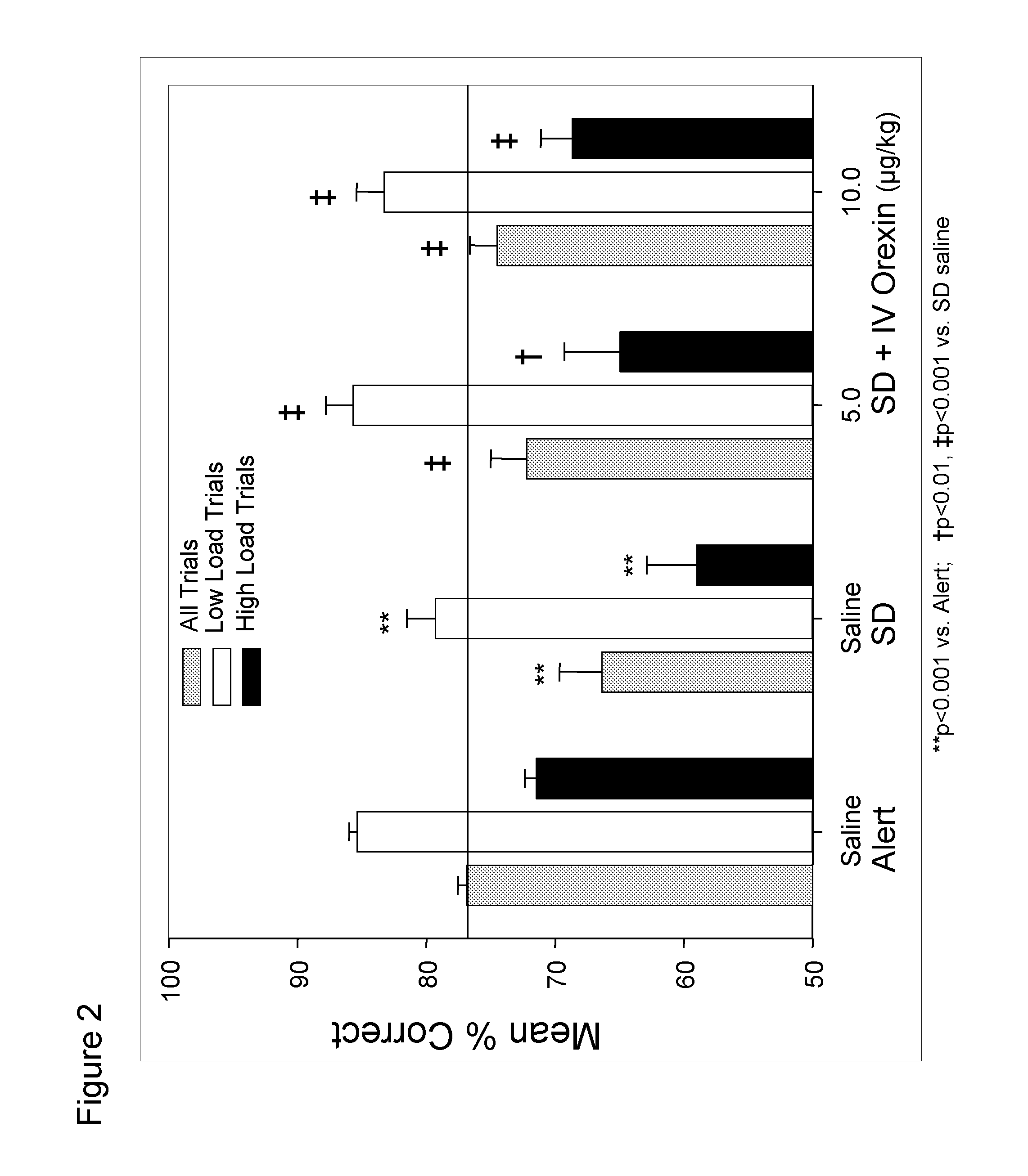Methods to reduce the effects of sleep deprivation
a technology of sleep deprivation and sleep deprivation, which is applied in the direction of peptides, drug compositions, peptides, etc., can solve the problems of affecting the behavioral performance of a variety of tasks, total or partial loss of sleep impairing the ability to correctly process information, and significant sleep deprivation in humans. to achieve the effect of treating or preventing symptoms
- Summary
- Abstract
- Description
- Claims
- Application Information
AI Technical Summary
Benefits of technology
Problems solved by technology
Method used
Image
Examples
example 1
Treatment of Sleep Deprivation and Cognitive Impairment
[0110]The effects of administering orexin-A to monkeys engaged in a cognitive task following 30-36 hrs of sleep deprivation are described, and the resulting changes in rates of local cerebral glucose metabolism (CMRglc) noted. This is the first instance in which Orexin-A has been employed via a novel application method to provoke increased levels of this peptide in the brain of nonhuman primates. We have determined that orexin-A applied via intranasal delivery can counteract the effects of sleep deprivation in nonhuman primates and that this procedure will have positive implications for adapting it to use in humans.
[0111]Hypocretin-1 (orexin-A) was administered to sleep deprived (30-36 hrs) rhesus monkeys immediately preceding testing on a multi-image delayed match to sample (DMS) short-term memory task. The DMS task employed multiple delays and numbers of stimulus images and has been shown to effectively measure cognitive defec...
example 2
Hyocretin Improves Cognitive Function in Drowsy Monkeys
[0137]Monkeys were tested at the end of their normal day 12 hr day at 4 PM, approximately 6-8 hours later than their normal testing period, in what can be considered a “drowsy” condition just prior to the onset of their dark cycle at 6 PM (Price 2003, Thomas 2000). At this time animals were impaired in performance relative to their normal testing times (high cognitive load: F(1.72)=8.49. p<0.001; extended delays-very high cognitive load: F(1.72)=5.84, p<0.01) during the day. This effect was reversed completely (high load: F(1.72)=6.17. p<0.01; extended delay: F(1.72)=8.42, p<0.001) by administration of the sleep peptide hypocretin-1 (orexin-A) delivered via a nasal spray mist aimed at the nostrils of each monkey at a dose of 1.0 μg (25 microgram / ml in 0.04 ml of saline) per estimated spray. F refers to an analysis of variance and the numbers in parentheses are the degrees of freedom, essentially the number of subjects and condit...
example 3
Treatment of Parkinson's Disease
[0138]Parkinson's disease (PD) is preceded and accompanied by daytime sleep attacks, nocturnal insomnia, REM sleep behavior disorder, hallucinations and depression, symptoms which are frequently as troublesome as the motor symptoms of PD. All these symptoms are present in narcolepsy, which is linked to a selective loss of hypocretin (Hcrt) neurons. We find that PD is also characterized by a massive loss of Hcrt neurons. Thus, the narcolepsy-like symptoms of PD can have the same cause and treatment as the symptoms of narcolepsy. We also see a substantial loss of hypothalamic melanin concentrating hormone (MCH) neurons. The losses of Hcrt and MCH neurons are significantly correlated with the clinical stage of PD, not disease duration, whereas the loss of neuromelanin cells is significantly correlated only with disease duration.
Introduction
[0139]Sleep disturbances with a prevalence that ranges from 74% to 98% [Mochizuki, 2006; Parkkinen, 2005] are major ...
PUM
| Property | Measurement | Unit |
|---|---|---|
| pH | aaaaa | aaaaa |
| concentration | aaaaa | aaaaa |
| concentration | aaaaa | aaaaa |
Abstract
Description
Claims
Application Information
 Login to View More
Login to View More - R&D
- Intellectual Property
- Life Sciences
- Materials
- Tech Scout
- Unparalleled Data Quality
- Higher Quality Content
- 60% Fewer Hallucinations
Browse by: Latest US Patents, China's latest patents, Technical Efficacy Thesaurus, Application Domain, Technology Topic, Popular Technical Reports.
© 2025 PatSnap. All rights reserved.Legal|Privacy policy|Modern Slavery Act Transparency Statement|Sitemap|About US| Contact US: help@patsnap.com



